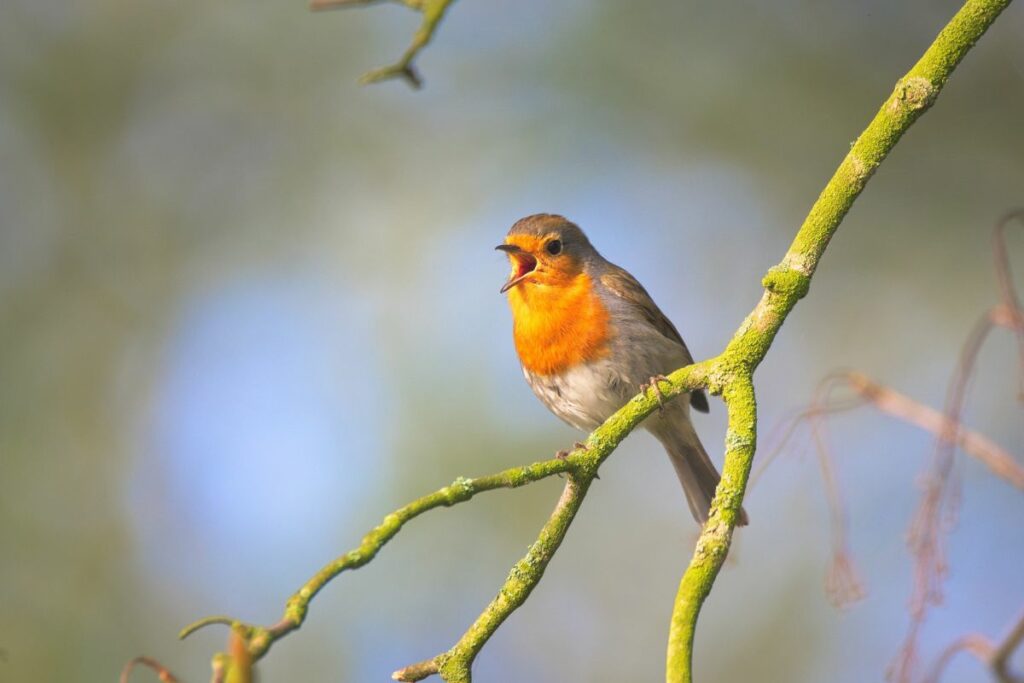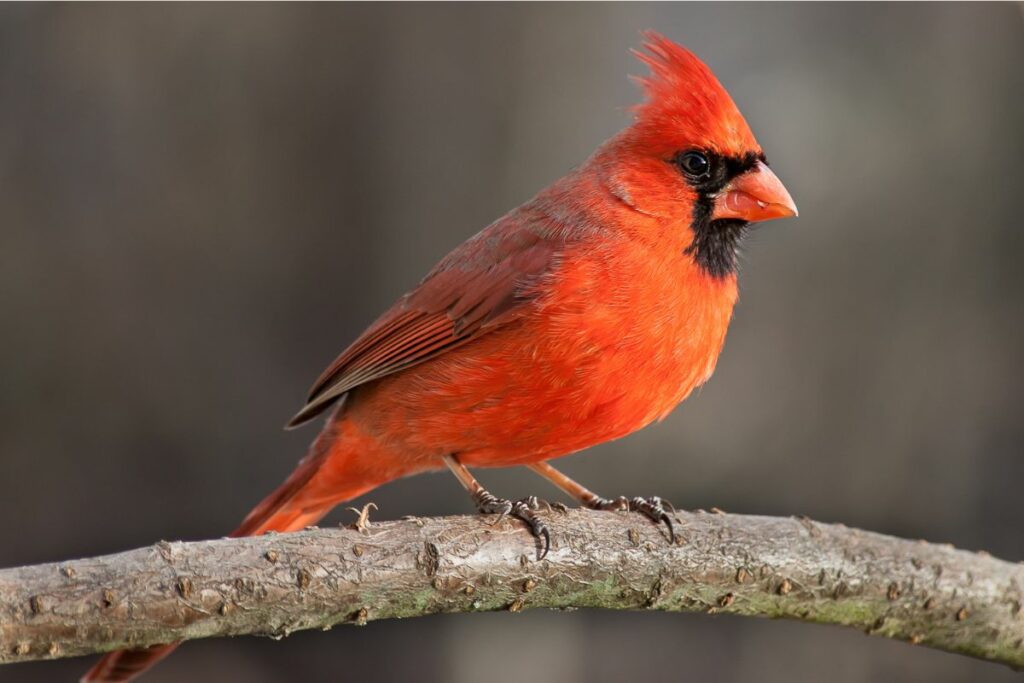As an Amazon Associate, we earn from qualifying purchases with no additional costs for you.
Birds are one of the animals that we think of as capable of a variety of vocalizations. Sound production is an important part of bird biology, serving many different functions. Besides bird songs, many species can also whistle. You me be curious as to how birds can whistle since they do not have lips.
Birds can whistle without lips due to an internal structure within their throats called a syrinx. Air moving over the membranes of the syrinx cause the structure to vibrate, which produces the vocalized whistles. This whistling can occur when the bird sucks air in or blows air out.
Birds are able to whistle because of their unique anatomy. It is the movement of air over the tympaniform membranes in the syrinx, which produces sound, including whistling sounds. Birds can whistle in and out; birds do whistle when they are happy but also for other reasons.
Read further to learn more about how birds whistle, why they whistle and which species whistle three times in a row.
TIP: If you want to check out the best pair of binoculars for bird watching, we recommend a pair of waterproof and fog-proof 8 x 42 binoculars like the Celestron – Outland X 8×42 Binoculars (Amazon link).
How Do Birds Whistle Without Lips?
Birds are able to produce sounds because of air moving over structures in the throat. This is similar to humans, where air passes over the vocal cords of the larynx. In humans, the larynx sits in the throat at the base of the windpipe. Humans typically whistle using their lips, but this is not how it works in birds.
Birds do not have a larynx. Instead, they have a structure known as a syrinx. Birds can whistle despite having no lips because of the syrinx and its structure.
The syrinx is at the base of the windpipe (trachea), which means that as air moves down into the windpipe (trachea), it has to pass through the syrinx.
The syrinx is positioned lower down the trachea compared to the larynx of humans. In birds, it is the movement of air over specific membranes known as the tympaniform membranes of the syrinx that allows sound to be produced.
These membranes in the syrinx serve a similar function to vocal cords. Various parts of the membrane vibrate as air passes over it; this produces sound. It is the vibration of different parts of the membrane that results in different sounds.
Do Birds Whistle In Or Out?
The birds are able to whistle when air moves in and out of the throat; in other words, sounds such as whistles can be produced when the bird breathes in and when the bird breathes out. In humans, whistling happens when we breathe out.
To better understand how birds can make whistling sounds, it is useful to learn more about the respiratory system of birds.
Birds have a complicated respiratory system, with air entering through the glottis (an opening) in the mouth and then passing down the trachea into tubes known as the bronchi and then into the posterior air sacs.
From these air sacs, air moves into the lungs and then into the anterior air sacs before being exhaled. Since the syrinx is located at the base of the trachea, sounds can be made when air passes over during both inhalation and exhalation.
Are Birds Happy When They Whistle?
Birds whistle when they are happy but this is also a behavior that can happen because of other situations that are important for bird biology.
Whistling As A Contact Call
Whistling can serve as a contact call, allowing birds to stay in contact with each other. Certain species, like raptors, can have a loud whistle.
A juvenile African Harrier Hawk can call for its parent by emitting a very loud whistling sound. This informs the parent hawk as to where the fledgling is and that the baby is hungry.
Whistling To Defend A Territory
The territoriality of birds has long been recognized as an important part of avian biology. Birds often establish an area that they find suitable for food and nesting.
This area is then defended from intruders. Vocalizations combined with aggressive interactions with competitors can help a bird remain in a suitable territory.
Whistling To Attract A Mate
Different species may sing or whistle to attract a mate. Birds do rely heavily on their plumage and coloration for attracting mates, but sound also plays a role in courtship behavior.
A loud whistle or song can alert a potential partner to the presence of the bird seeking a mate. A female bird can also recognize if the male that is singing is the same species.
While a male bird may whistle or may sing in a particular way in an attempt to attract a mate, other behaviors also play a role. The whistling or song can be combined with dancing or specific courtship flights.
Such vocalizations and other behaviors can help indicate that a male bird is fit and is looking for a mate. A female bird can assess a male’s readiness and fitness for breeding based on his song and other behaviors.
Whistling As An Alarm Call
In some cases, birds vocalize to signal danger. The presence of a potential predator, such as a hawk or falcon, snake, or mammal (such as a dog or cat), can cause birds to alarm.
A call that functions as an alarm is usually a short whistle or some other sound that is quite distinct from the usual sounds that a species typically makes.
Other birds, including different species, will recognize that the whistle or call is an alarm of some sort. This then triggers them to behave differently. The type of behavior depends on the predator. If a falcon flies over, birds will often fall silent and may hide.
In other cases, such as a snake being spotted, birds move near to the alarming bird to further investigate the situation and determine exactly where the danger is.
A bird that alarm-whistles because of spotting a snake in a tree will very quickly become surrounded by birds of its own and other species. Soon all birds in the area will alarm at the intruder and source of danger. This can dissuade a potential predator.
Some bird species not only alarm whistle or call but may physically attack and peck at a potential predator in the hopes it will move off. The alarm reaction is often stronger if there is a nest or chicks nearby. Even a venomous snake may be confronted and pecked by birds that have a nest in the vicinity.
Whistling By Bird Mimics
Some birds are clever mimics, able to copy several sounds (including whistles) that they hear in their environment. Mockingbirds are one such species, that can mimic whistles and other sounds they hear in their neighboring area. The Superb Lyrebird of Australia can mimic any sound it hears, including whistles.
Pet birds of some species can also copy what they hear. Birds in the parrot and starling families are adept at mimicry and can learn to copy their owners when they whistle. They can also copy speech.
What Bird Whistles 3 Times in a Row?
There is variation in how birds whistle, with some species producing a one-note whistle, while other species produce whistles that are several notes.
There is more than one species of bird that can whistle three times in a row. The Northern Cardinal is one such bird, but sometimes the call is only two notes, or it is several notes.
Other species have four notes; for instance, species like the White-throated Sparrow have a distinctive whistling song. There can be variation in the call repertoire of birds, with some having a mixture of whistles and other sounds.
Sparrows and cardinals are in the group of birds known as passerines, but there are other types of birds that also whistle.
Waterfowl that are well-known as whistlers, include the Black-bellied Whistling Duck and White-faced Whistling Duck. Whistling ducks are easy to hear from a distance as they have a loud and very obvious whistle and are even named for their whistling call.
Raptors can sometimes have a whistle as part of their call. Broad-winged Hawks are an example of a bird of prey that has a whistle for a call.
Variation And Sexual Dimorphism
There is sometimes sexual dimorphism in the ability of birds to whistle or make other sounds. In other words, the males and females of the species vocalize differently.
This can sometimes be due to structural differences between the male and female syrinx. For instance, there are differences in the syrinx and tympaniform membranes between male and female mallards. The result is that different sounds are made depending on the sex of the duck.
TIP: Knowing how to spot the birds in your yard is key to enjoying visits from your winged friends as much as possible! The best sources are trusted books, I recommend using the following (Amazon links):
– National Geographic Field Guide to the Birds of North America
– National Audubon Society Birds of North America
Conclusion
Birds are able to whistle even though they don’t have lips. This is because of the particular anatomy of the bird’s respiratory system, specifically the syrinx.
Sound (including whistling) is produced when air flows over sections of the tympaniform membrane found inside the syrinx of birds. The membrane vibrates to produce sound.
Vocalizations, including whistles, can serve many different functions in the life of a bird. Birds can use whistles as contact calls, to attract a mate, defend a territory, and as an alarm to indicate a predator is in the area.
Birds may also mimic other birds and even humans, adding to the variety of whistles and other sounds that they make.




